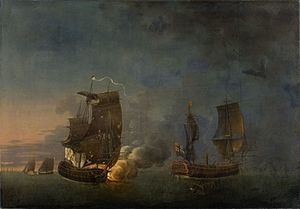Name Aréthuse Commissioned 1757 Name HMS Arethusa Length 40 m Displacement 635,000 kg | Namesake Arethusa (mythology) Fate Captured Launched December 1757 Weight 711.2 tons | |
 | ||
Captured by the Royal Navy, 18 May 1759 | ||
Aréthuse was a French frigate, launched in 1757 during the Seven Years' War. She was subsequently captured by the Royal Navy and became the fifth-rate HMS Arethusa.
Contents
French service
The ship was constructed at Le Havre for privateer warfare as Pélerine. Soon after her launch, she was purchased by the King and commissioned as Aréthuse on 21 January 1758.
In June, under captain Vauquelin, she sailed through the British blockade of Louisbourg. She helped defend the site before departing, again forcing the blockade.
On 18 May 1759, she was in transit from Rochefort to Brest, under the command of the Marquis Vandrenil, when she was intercepted near Audierne Bay (Baie d'Audierne(French)) by three Royal Navy ships - Thames, Venus and Chatham. She attempted to escape but after two hours, she lost her top-masts and was overtaken by her pursuers. Thames and Venus engaged her with heavy fire, causing 60 casualties before she surrendered.
Royal Navy service
She entered service with the Royal Navy. For the rest of the war, she was in service in British home waters and was responsible for the capture of several French, privateer cutters.
In 1777, a Scotsman James Aitken, widely known as John the Painter, was hanged from her mizzenmast for burning the Rope House at Portsmouth Royal Dockyard on 7 December 1776, to aid the cause of American independence . The mast was struck from the ship and re-erected at the dockyard entrance so as many people as possible could watch the execution.
On 17 June 1778, she fought a famous duel against the French, 26-gun frigate, Belle Poule. Belle Poule was on a reconnaissance mission, along with the 26-gun Licorne, the corvette Hirondelle and the smaller Coureur when she encountered a large British squadron that included Arethusa at a point 23 miles (37 km) south of The Lizard. Admiral Keppel, commanding the British fleet ordered that the French ships be pursued.
The captain of Belle Poule refused the order to sail back to the British fleet. The British fired a warning shot across his ship's bow, to which he responded with a full broadside. This began a furious, two-hour battle between the two ships that resulted in the deaths of the French second captain and 30 of the crew. However, Arethusa was crippled by the loss of a mast and withdrew, allowing Belle Poule to escape.
This battle was the first between British and French naval forces during the American Revolutionary War and took place around three weeks before the formal declaration of war by France.
The battle was widely celebrated in France as a victory, even inspiring a hair-style in court circles that included a model of Belle Poule. It was also viewed as a victory in Britain and became the subject of a traditional Sea shanty, The Saucy Arethusa (Roud # 12675). Arethusa is also the subject of a song on the Decemberists' album Her Majesty the Decemberists.
On 18 March 1779, under captain Charles Holmes Everitt, Arethusa engaged the French Aigrette, sustaining considerable damage in the fight. Arethusa was wrecked the next day off Ushant, at a point 48°27′4″N 5°4′4″W.
It was apparently the fame of this Arethusa which induced the Royal Navy, during the following two centuries, to bestow the name on a further seven consecutive individual ships (see HMS Arethusa) and two consecutive classes of cruisers (see Arethusa-class cruiser).
